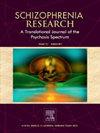Genetic overlap between household income and psychiatric disorders
IF 3.6
2区 医学
Q1 PSYCHIATRY
引用次数: 0
Abstract
Household income (HI), a significant socioeconomic factor influencing mental health, has seen its association with various mental disorders garnering increasing attention. However, the common genetic basis between HI and psychiatric disorders remains poorly understood. Utilizing genome-wide association study (GWAS) pooled statistics for HI, schizophrenia (SCZ), attention deficit hyperactivity disorder (ADHD), bipolar disorder (BIP), and autism spectrum disorders (ASD), bivariate mixed models of causality (MiXeR) were employed to quantify the shared genetic architecture between HI and psychiatric disorders. The conjunctional false discovery rate (conjFDR) approach was utilized to identify specific shared loci, and the resulting shared genetic loci were analyzed for functional annotation and gene set enrichment. The MiXeR analysis revealed that among the 8.9 K variants affecting HI, 8.7 K were shared with SCZ, 7.8 K with ADHD, 6.2 K with BIP, and 8.7 K with ASD. A total of 344 shared genetic loci were identified between HI and psychiatric disorders using the conjFDR method, with 254 of them being novel. Additionally, the shared loci of HI with SCZ and ADHD mainly demonstrated opposite effect directions, while those with BIP and ASD mainly exhibited mixed effect directions. Functional annotation indicated that the shared genetic loci were predominantly located in intronic and intergenic regions, and enrichment analysis demonstrated that they were involved in nervous system development, multicellular organism development, and neuron differentiation. In conclusion, our study reveals a shared genetic architecture between HI and psychiatric disorders, highlighting common biological processes that may contribute to understanding their complex etiologies and overlapping genetic mechanisms.
家庭收入和精神疾病之间的基因重叠
家庭收入是影响心理健康的一个重要社会经济因素,其与各种精神障碍的关系日益受到关注。然而,HI和精神疾病之间的共同遗传基础仍然知之甚少。利用全基因组关联研究(GWAS)汇总了HI、精神分裂症(SCZ)、注意缺陷多动障碍(ADHD)、双相情感障碍(BIP)和自闭症谱系障碍(ASD)的统计数据,采用双变量因果关系混合模型(MiXeR)来量化HI和精神疾病之间的共享遗传结构。利用联合错误发现率(conjunctional false discovery rate, conjFDR)方法识别特定的共享基因座,并对得到的共享基因座进行功能注释和基因集富集分析。MiXeR分析显示,在影响HI的8.9个K变异中,8.7个K与SCZ共有,7.8个K与ADHD共有,6.2个K与BIP共有,8.7个K与ASD共有。使用共轭fdr方法共鉴定出344个在HI和精神疾病之间共享的基因位点,其中254个是新的。此外,HI与SCZ和ADHD的共享位点主要表现为相反的作用方向,而BIP和ASD的共享位点主要表现为混合作用方向。功能注释表明,共享基因位点主要位于内含子区和基因间区,富集分析表明它们参与了神经系统发育、多细胞生物发育和神经元分化。总之,我们的研究揭示了HI和精神疾病之间共享的遗传结构,强调了可能有助于理解其复杂病因和重叠遗传机制的共同生物学过程。
本文章由计算机程序翻译,如有差异,请以英文原文为准。
求助全文
约1分钟内获得全文
求助全文
来源期刊

Schizophrenia Research
医学-精神病学
CiteScore
7.50
自引率
8.90%
发文量
429
审稿时长
10.2 weeks
期刊介绍:
As official journal of the Schizophrenia International Research Society (SIRS) Schizophrenia Research is THE journal of choice for international researchers and clinicians to share their work with the global schizophrenia research community. More than 6000 institutes have online or print (or both) access to this journal - the largest specialist journal in the field, with the largest readership!
Schizophrenia Research''s time to first decision is as fast as 6 weeks and its publishing speed is as fast as 4 weeks until online publication (corrected proof/Article in Press) after acceptance and 14 weeks from acceptance until publication in a printed issue.
The journal publishes novel papers that really contribute to understanding the biology and treatment of schizophrenic disorders; Schizophrenia Research brings together biological, clinical and psychological research in order to stimulate the synthesis of findings from all disciplines involved in improving patient outcomes in schizophrenia.
 求助内容:
求助内容: 应助结果提醒方式:
应助结果提醒方式:


